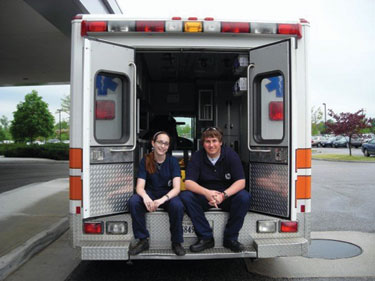Help on the way from EMTs
The Captain's Log, Vol. 39 Iss. 17
By Erin Roll, Asst. Copy Editor
The extracurricular volunteer work of several student emergency medical technicians, (EMTs) may soon yield great dividends for campus residents in a crisis situation. Two members of the SGA plan to propose a network of CNU students who are trained as EMTs to help respond to medical emergencies on campus.
Meris Shuwarger, a sophomore, and Taylor Blunt, a junior, presented the idea of a student EMT network last semester to the SGA. Shuwarger and Blunt are licensed EMTs with the Isle of Wight County Fire Department.
The idea for a CNU student rescue squad had been brought up several times in past years, but the idea gained more momentum after the shootings at Virginia Tech, Blunt and Shuwarger said.
Under the plan, student EMTs would respond to medical emergencies. Their job would be to assess the situation and help monitor any illnesses or injuries while waiting for a rescue squad from the Newport News Fire Department to arrive.
Shuwarger introduced the idea, under the name of Campus Rescue, during the SGA’s Oct. 1, 2007 meeting. However, according to Vice President of the Senate Ben Heath, the idea has not been discussed with the SGA during its meetings since then.
The list of Virginia colleges and universities that have student-staffed rescue squads include Virginia Tech, University of Virginia, Lynchburg College, Radford University and Hampden-Sydney College, according to the Web site of the National Collegiate EMS Foundation.
Both Shuwarger and Blunt acknowledged that CNU’s small size, in comparison to other schools, and location in a metropolitan area, might preclude starting a rescue squad on campus.
However, they pointed out that certain on-campus medical emergencies and life-threatening situations would call for an on-campus squad.
“If you’ve got someone who’s unconscious, you’ve got four minutes to bring them back,” Shuwarger said. She said those minutes run out quickly if an ambulance cannot immediately come to campus.
There is also the matter of being familiar with the CNU campus.
“We know the campus, we know the buildings,” said Shuwarger. Shuwarger and Blunt pointed out that dispatchers frequently have to give ambulance drivers directions to a particular building on campus.
As long as the student EMTs were fully certified, a student EMT network would be helpful to incoming rescue squads, wrote Dana Perry, public information officer for the Newport News Fire Department, in an e-mail.
If some of the student EMTs were certified outside of the Commonwealth of Virginia, their actions would fall under the Good Samaritan Act. Under this act, if an untrained or uncertified person acts with good intent to help save a patient’s life, but the patient becomes seriously ill or dies, the would-be rescuer would not be held accountable in court. EMTs certified in Virginia, however, could be held accountable.
In one incident last semester, Shuwarger said, a number of students present happened to be licensed EMTs, but were not able to use their skills due to an absence of equipment.
Part of the network’s duties would include training CNU students, faculty and staff in first-aid and life-saving techniques. These would include cardiopulmonary resuscitation (CPR) and the use of an automatic external defibrillator (AED).
The squad would also, Blunt said, be present at large events at CNU, such as sporting events, which usually have a Newport News ambulance and EMTs present.
A CNU student EMT squad would work in association with the CNU Police Department and with the Newport News Fire Department. Shuwarger and Blunt plan to discuss the idea with them before making a formal presentation to the administration. However, no formal date or plans have been set at this time.
“I think it’s hard not to be in favor of something that will save lives,” Blunt said.
 Photo Provided by Meris Shuwarger
Photo Provided by Meris Shuwarger
Emergency Medical Technicians Meris Shuwarger and Timothy Jaffry in their ambulance.